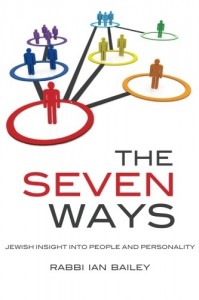by The7Ways | Nov 18, 2011 | Rabbi Bailey’s Blog
The Seven Ways: Practical Applications
PDF Practical Applications Chaye Sarah
Milo Taphinn is an impeccably dressed artist who enjoys venturing into (more…)
by The7Ways | Nov 11, 2011 | Rabbi Bailey’s Blog
Deeper Levels of a Famous Story
Avraham Less Chesed PDF
You’ve probably heard inspiring speeches, based on (more…)
by The7Ways | Nov 4, 2011 | Rabbi Bailey’s Blog
Home is Where the Mind Is
PDF Avraham Homeland
The question that I sent out earlier this week read: (more…)
by The7Ways | Oct 31, 2011 | Rabbi Bailey’s Blog
Help Me Answer a Question
After telling Avraham that he should go to a (more…)
by The7Ways | Oct 28, 2011 | Rabbi Bailey’s Blog
Noach: Find Sefirot Throughout Your Life:
New Parallels of Sefirot & Psychology
PDF Sefirot and the Life Cycle
Buy the Book
In honor of the Torah Portion of Noach, (more…)
by The7Ways | Oct 23, 2011 | Rabbi Bailey’s Blog
Feeling Bad Can Cause Negative Actions
Over the weekend I realized that I would not have the possibility to post (more…)
by The7Ways | Oct 19, 2011 | Rabbi Bailey’s Blog
Leaving the Sukkah: Getting High with a Higher Authority
At the End of Days, all of the nations of the world will come to G-d and ask to receive (more…)
by The7Ways | Oct 5, 2011 | Rabbi Bailey’s Blog
Toward A More Meaningful Ushpizin
On Sukkot, we commemorate Israel’s dwelling in the desert in sukkahs with G-d’s protection. There is a custom to (more…)
by The7Ways | Sep 26, 2011 | Rabbi Bailey’s Blog
Help Me Answer a Question + A Sefirah a Day
The Toldot Yitzchak, a student of a student of a student of the famous Vilna Gaon (Gra), breaks down the 365 day solar year into two meaningful numbers: 343 and (more…)
by The7Ways | Sep 23, 2011 | Rabbi Bailey’s Blog
Nitzavim: Less is More; Anatomy of an Indulgence
For young Rabbi Shaya Kohn, dealing with drugs addicts and dropouts was a daily drama for over eight years. Kohn, who now helps young men earn GEDs at an alternative Jewish school, is a caring, energetic rabbi of medium hight and build, with a thick, bristly beard, and a perpetual smile spread wide on his face. When you meet him, R’ Kohn makes you (more…)
by The7Ways | Sep 14, 2011 | Rabbi Bailey’s Blog
Key Tavo: He Doesn’t Hate You, You Read It Wrong; When Assistance Is Met With Rudeness
Have you ever offered to help someone and they brushed you off or ignored you? Have you ever helped someone and they did not say (more…)
by The7Ways | Sep 9, 2011 | Rabbi Bailey’s Blog
The Biblical Connection:
Desire, Romance, and Attachment
Psychologists discuss the underlying psychological and biological (“biobehavioral”) ways in which we form intimate relationships. Once someone has found and spends time with the type of partner whom he or she prefers (correct temperament, mannerisms, background, etc.), that person is likely to develop fond feelings

for the partner and find his- or herself with what is plainly labeled by psychologists as (intimate) drive or desire for the other person. This is often coupled with or followed by what is called romantic love. The former is more deeply rooted in biology, but is connected to actions and thoughts, while the latter is something that may occur in such unhealthy ways as a quickly created obsession or, hopefully, grow healthily and naturally over time, as the couple spends time together and relates.
What is missing from this list is a third, well-known and intriguing biobehavioral system called attachment. When a couple initially connects, they may feel passionate feelings or the desire to connect physically, and these feelings can be healthy, proper feelings and lead to a healthy relationships and marriage, but they still are missing the healthy, true bond of attachment that is present in real relationships. This attachment is essential, because after this bond is created, the tone of the romance and desire components of the relationship are dictated by the quality of the relational bond of the couple (!). (All who want to work on themselves and their marriages will have more romance and love- it’s not something you can buy or order up!)
In their comprehensive work on psychological aspects of the family life cycle, McGoldrick, Carter and Garcia-Preto, (2011) discuss this bond, and explain that it is usually created after a year or two of a couple living together,  specifically when romantic love wanes to near non-existence. This observation by non-Jewish, clearly anti-(traditional) religious professors is, not coincidentally, the biobehavioral background for what Jews knew centuries ago: that “Shana Rishona” “The first year” that a couple spends together (based on Duet. 24:5) is crucial. Newlyweds spend down-to-earth quality time together during this year, with the husband not traveling or risking his life in war, so that the couple can form a healthy bond (after that, risk away!). This quality time has been demonstrated to be essential to healthy marriages by Dr. John Mordechai Gottman, who has penned his findings in practical advice and digestible content in The Seven Principles for Making Marriage Work (Gottman & Silver, 1999).
specifically when romantic love wanes to near non-existence. This observation by non-Jewish, clearly anti-(traditional) religious professors is, not coincidentally, the biobehavioral background for what Jews knew centuries ago: that “Shana Rishona” “The first year” that a couple spends together (based on Duet. 24:5) is crucial. Newlyweds spend down-to-earth quality time together during this year, with the husband not traveling or risking his life in war, so that the couple can form a healthy bond (after that, risk away!). This quality time has been demonstrated to be essential to healthy marriages by Dr. John Mordechai Gottman, who has penned his findings in practical advice and digestible content in The Seven Principles for Making Marriage Work (Gottman & Silver, 1999).
It is up to the couple to spend quality time together and rid themselves of unhealthy attachments, in order to properly connect.
“Therefore, a man will forsake his father and his mother and attach to his wife, and they will become one flesh.”
(Gen. 2:24)
This sentence, which many of us have heard and read on numerous occasions, has much significance, when understood in the light of Jewish tradition and contemporary psychological theory. As highlighted by the bolded letters, the sentence does not read ‘a man will have left’ ‘ne’ezav’ in the passive, but ‘will forsake’. The sentence is saying it as an imperative for, not a description of, a man to forsake the unhealthy attachments from his youth, in order to actively form the bond with his wife. (More on this in Parashat Lech-Lecha, which will be based on a workshop that I give entitled “Leaving Charan”).
Anyone who is married can attest to the fact that these attachments are what couples deal with for some time, especially at the beginning of marriage (Why do you need your food so badly? Why do you speak with your mother so often, it hurts our relationship? We need the money, why can’t I take this new job and move away from your family? We need to be independent). Also, new attachments are what each spouse picks up on in their partner and naturally rejects (Honey, you just quit smoking but replaced it with drinking caffeine. Is everything ok, since we moved away from your sister, you call me very often, when I am at work?).
The Biblical Roots
There is a very interesting law that a Jewish soldier is allowed to take a women from a non-Jews enemy nation and perform a conversion process on her and marry her (Deut. 21:10-14). During her conversion process, he must have her look disheveled and mourn her former family. After a man marries such a woman, he may he may end up staying married to her, or if he finds himself
“…not desiring her, he can send her ‘self’ [lenafsha] away…”
Scripture heralds that [his] destiny is to hate her.
(Deut. 21:24, with Rashi)
The Torah and Rashi are explaining that when a man is compelled to send away a woman such as this, that his attachment to her was solely to her appearance. Lenafsha is an extra word here; it means her ‘self’ in a very deep way. It is the same word as soul, and is used to describe life (as in the story of Creation). In conjunction, the Torah did not use a more common word for desire ratza ‘to want something’, but chafetz,  which has the connotation more of desiring an object (which is why the noun c’hefetz’ means ‘object’). He is essentially sending away an object that he was attached to, not the woman that she truly is.(1)
which has the connotation more of desiring an object (which is why the noun c’hefetz’ means ‘object’). He is essentially sending away an object that he was attached to, not the woman that she truly is.(1)
This soldier doesn’t really like her inner self, her true essence as a person. This section of the Torah, as has been said, is attempting to drive this woman away from the man, because, for some reason that needs explanation, our sages say that soldiers cannot help but desire these types of women during battle, and the Torah, consequently, made a mechanism to attempt to remove her from his life (Rashi, Talmud Kiddushin). With our understanding of attachment, this mechanism works quite well. It will dissolve this man’s attachment to her, through making her do these mournful actions and removing romantic love and desire; the couple has no real attachment, and, if they do, they will stay married (King David has many such wives, so I cannot fully disparage the idea). The analogy to relationships in life’s everyday interactions is clear. As with Amnon and Tamar, looks alone are not what form a healthy connection; they create but a romantic obsession.
[Order The Seven Ways! today! Now only $14.95 and $2.99 eBook]
May we all detach from unhealthy attachments and create healthy attachments with healthy people and constructive concepts.
IB
(1) Rashi sounds like he is saying that every person who does this will hate the woman. He may mean this quite literally: that anyone who actually succeeds in marrying her totally changed his attachment to the woman, but always ran the risk of hating or did hate her.
Bibliography
McGoldrick, M., Carter, B., and Garcia-Preto, N., (2011). The Family Life Cycle: Individual, Family, and Social Perspectives . Boston: Allyn and Bacon
Gottman, J., Silver, N. (1999). The Seven Principles for Making Marriage Work. New York: Crown Publishers.

 specifically when romantic love wanes to near non-existence. This observation by non-Jewish, clearly anti-(traditional) religious professors is, not coincidentally, the biobehavioral background for what Jews knew centuries ago: that “Shana Rishona” “The first year” that a couple spends together (based on Duet. 24:5) is crucial. Newlyweds spend down-to-earth quality time together during this year, with the husband not traveling or risking his life in war, so that the couple can form a healthy bond (after that, risk away!). This quality time has been demonstrated to be essential to healthy marriages by Dr. John Mordechai Gottman, who has penned his findings in practical advice and digestible content in The Seven Principles for Making Marriage Work (Gottman & Silver, 1999).
specifically when romantic love wanes to near non-existence. This observation by non-Jewish, clearly anti-(traditional) religious professors is, not coincidentally, the biobehavioral background for what Jews knew centuries ago: that “Shana Rishona” “The first year” that a couple spends together (based on Duet. 24:5) is crucial. Newlyweds spend down-to-earth quality time together during this year, with the husband not traveling or risking his life in war, so that the couple can form a healthy bond (after that, risk away!). This quality time has been demonstrated to be essential to healthy marriages by Dr. John Mordechai Gottman, who has penned his findings in practical advice and digestible content in The Seven Principles for Making Marriage Work (Gottman & Silver, 1999). which has the connotation more of desiring an object (which is why the noun c’hefetz’ means ‘object’). He is essentially sending away an object that he was attached to, not the woman that she truly is.(1)
which has the connotation more of desiring an object (which is why the noun c’hefetz’ means ‘object’). He is essentially sending away an object that he was attached to, not the woman that she truly is.(1)